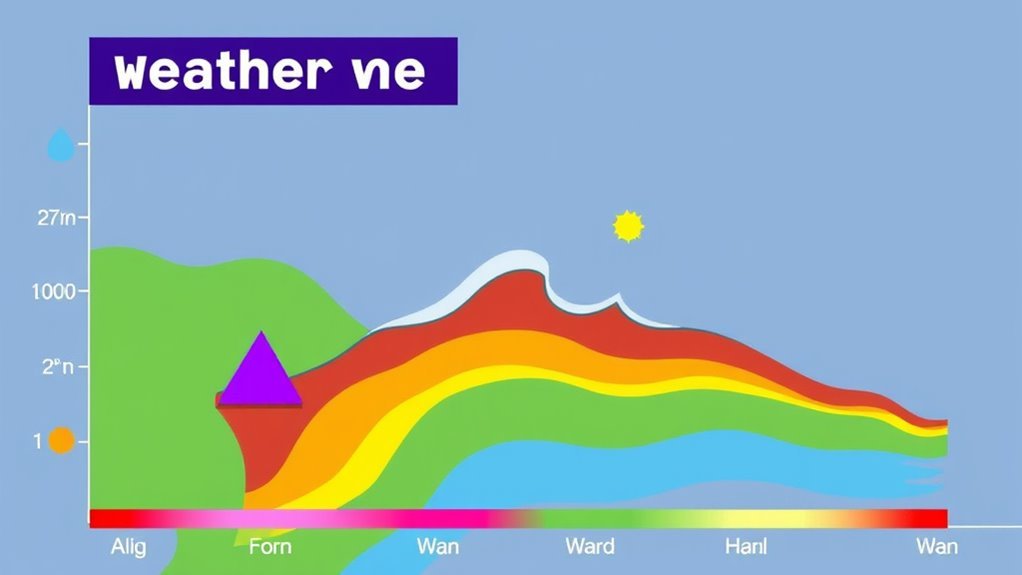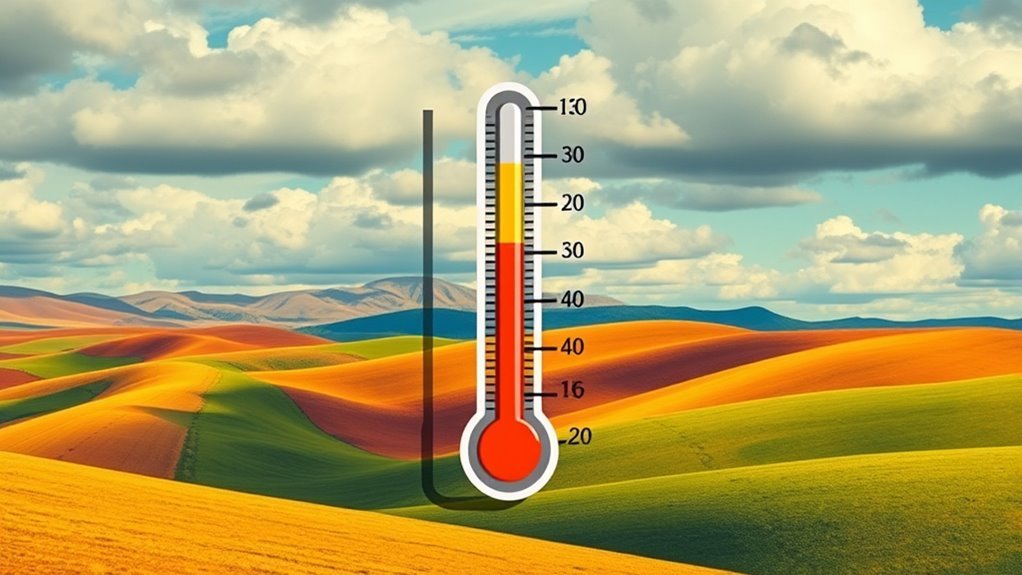Weather maps visually represent atmospheric conditions, showcasing temperature, precipitation, and pressure systems. Key symbols include cold fronts marked by blue lines with triangles and low-pressure areas denoted by "L." Squalls form due to atmospheric instability, driven by temperature contrasts between air masses. Factors like wind shear and geographical features improve squall intensity. Understanding these elements is essential for safety during sudden weather changes. There's much more to investigate about interpreting these dynamics further.
Main Points
- Weather maps display temperature, precipitation, and pressure systems using symbols like "H" for high pressure and "L" for low pressure.
- Cold fronts are indicated by a blue line with triangles, while warm fronts are represented by a red line with semicircles.
- Squalls form from atmospheric instability, where warm, moist air rises rapidly through cooler air, causing sudden weather changes.
- Wind shear enhances squall intensity by creating turbulence and precipitation through interactions between different wind layers.
- Monitoring weather alerts and seeking shelter during squalls can improve safety, as conditions can change rapidly and unpredictably.
The Basics of Weather Maps
Weather maps serve as essential tools for understanding atmospheric conditions and predicting future weather patterns. These maps provide a visual representation of various meteorological data collected from multiple sources, including satellites, weather stations, and radars.
They typically display elements such as temperature, precipitation, wind speed, and pressure systems, allowing users to decipher complex weather information quickly. The layout of weather maps often includes regions marked with different colors to indicate temperature variations and precipitation levels.
Fronts, which signify changes between air masses, are also depicted, showing how weather may change in specific areas. By analyzing these components, individuals can garner knowledge into potential weather events, such as storms or heatwaves.
Key Symbols and Their Meanings

Symbols on weather maps play an essential role in conveying critical information about atmospheric conditions. These symbols represent various meteorological phenomena, helping users interpret forecasts quickly.
For instance, a blue line with triangle points indicates a cold front, while a red line with semicircles signifies a warm front. Areas of high pressure are marked with an "H," suggesting clear skies and stable weather, whereas low-pressure areas, denoted by an "L," often indicate unsettled conditions and potential storms.
Precipitation is represented by various symbols; raindrops, snowflakes, and sleet icons provide visual cues about expected weather. Additionally, isobars, which are lines connecting points of equal atmospheric pressure, illustrate wind patterns and help predict weather changes.
Understanding these symbols equips individuals with the knowledge to make informed decisions based on weather forecasts, enhancing preparedness for varying conditions.
Understanding Atmospheric Pressure
Atmospheric pressure, a fundamental aspect of meteorology, refers to the weight of air above a particular point in the atmosphere. It is measured in units such as millibars or inches of mercury and plays a significant role in weather patterns.
High-pressure systems are defined by descending air, leading to clear skies and stable conditions. Conversely, low-pressure systems are associated with rising air, which can result in cloud formation and precipitation.
The distribution of atmospheric pressure across the globe influences wind patterns, as air moves from areas of high pressure to low pressure. This movement is essential for various weather phenomena, including squalls.
Forecasters analyze pressure gradients to predict changes in weather, as steep gradients often result in strong winds and rapidly changing conditions. Understanding atmospheric pressure is therefore important for interpreting weather maps and anticipating weather events effectively.
The Role of Temperature in Weather Patterns

Temperature serves as a critical factor in shaping weather patterns and influencing daily climate variations. Variations in temperature can lead to different atmospheric behaviors, impacting humidity levels, precipitation, and storm development. Understanding how temperature interacts with other meteorological elements is essential for interpreting weather maps accurately.
Key aspects of temperature's role in weather include:
- Thermal Imbalances: Differences in temperature between land and water can create pressure gradients, leading to wind formation and localized weather changes.
- Humidity Influence: Warmer air can hold more moisture, affecting cloud formation and precipitation likelihood. As temperatures rise, the potential for severe weather increases.
- Seasonal Changes: Seasonal temperature fluctuations dictate the onset of weather phenomena, such as monsoons and winter storms, influencing long-term climate patterns.
Wind Patterns and Their Impact on Squalls
Wind patterns play an important role in the formation and intensity of squalls.
The influence of the jet stream can create notable shifts in weather dynamics, while local topography can further exacerbate these effects.
Understanding these interactions is vital for predicting squall behavior and its potential impacts.
Jet Stream Influence
The jet stream serves as a vital driver of weather patterns, influencing the formation and intensity of squalls. This high-altitude wind current plays a notable role by shaping atmospheric conditions, which can lead to sudden and severe weather changes.
The interaction between the jet stream and lower atmospheric systems is important in determining squall development.
Key influences of the jet stream on squalls include:
- Temperature Gradients: Sharp temperature differences can improve squall intensity.
- Moisture Transport: The jet stream can carry moist air into regions, fueling squalls.
- Turbulence and Instability: Changes in jet stream speed and direction can create turbulence, leading to squall formation.
Understanding these dynamics is essential for accurate weather forecasting.
Local Topography Effects
Local topography greatly influences wind patterns and can improve the development of squalls. Variations in terrain, such as mountains, valleys, and bodies of water, can alter airflow, creating localized wind systems.
For instance, when winds encounter a mountain range, they are forced to rise, cooling and condensing moisture, which can lead to intense precipitation and squall formation. Conversely, in valleys, winds may funnel and accelerate, potentially enhancing squall strength.
Additionally, coastal areas often experience temperature contrasts between land and sea, generating sea breezes that can converge with inland winds, further intensifying squall activity.
Understanding these topographical effects enables meteorologists to predict squalls more accurately, helping to mitigate their impact on communities.
What Causes a Squall?
A squall is primarily caused by atmospheric instability, which can lead to sudden changes in weather conditions.
Wind shear also plays a critical role, as variations in wind speed and direction can amplify the intensity of these storms.
Additionally, contrasting temperatures between air masses contribute to the formation and strength of squalls.
Atmospheric Instability Factors
Atmospheric instability serves as a fundamental driver behind the formation of squalls, sudden and intense weather disturbances. This instability occurs when warm, moist air rises rapidly through cooler air, creating conditions conducive to squall development.
Several factors contribute to this phenomenon:
- Temperature Differentials: A notable temperature contrast between surface and upper air layers improves buoyancy, prompting rapid ascent of warm air.
- Moisture Availability: High humidity levels in the lower atmosphere provide ample moisture, fueling storm development and intensifying precipitation.
- Topographical Influences: Mountains or geographical features can disrupt airflow, leading to localized lifting and improving atmospheric instability.
Understanding these factors is essential for predicting the occurrence of squalls and preparing for their potentially severe impacts.
Wind Shear Influence
The dynamics of wind shear play an essential role in the development of squalls. Wind shear refers to the change in wind speed and direction at different altitudes.
When strong wind shear occurs, it can create a vertical imbalance in the atmosphere. This imbalance allows for the rapid upward movement of air, leading to the formation of cumulonimbus clouds, which are often associated with squalls.
The intense updrafts generated by wind shear contribute to the organization of storm systems, enhancing their strength and severity.
In addition, the interaction between different layers of wind can initiate turbulence and precipitation, resulting in sudden and severe weather changes.
Understanding wind shear is vital for predicting squall formations and their potential impacts.
Temperature Contrast Effects
When warm, moist air collides with cooler, denser air, considerable temperature contrasts can lead to the formation of squalls. This interaction often results in rapid changes in weather conditions, marked by intense winds and sudden precipitation. The dynamics of temperature contrast play a vital role in the strength and duration of these squalls.
Factors contributing to squall formation include:
- Air Mass Boundaries: The collision of different air masses creates instability, prompting rapid vertical lift.
- Geographical Features: Mountains and valleys can improve temperature differences, accelerating squall development.
- Seasonal Variations: Seasonal shifts can boost temperature contrasts, particularly during changing weather periods.
Understanding these elements is essential for predicting squall occurrences and their potential impact on weather conditions.
Tips for Staying Safe During Squalls
Although squalls can develop rapidly and catch individuals off guard, staying safe during such events is essential. It is advisable for individuals to monitor weather forecasts and alerts regularly, especially when engaging in outdoor activities. Preparing an emergency kit that includes water, food, and first aid supplies can also be beneficial.
When a squall is imminent, seeking shelter in a sturdy building is critical. If caught outdoors, individuals should avoid open areas and seek low-lying ground to reduce exposure to strong winds and lightning.
Driving during a squall can be dangerous; reducing speed and staying alert for sudden changes in visibility is imperative.
Finally, remaining indoors until the storm has completely passed guarantees safety from unexpected gusts or debris. Adhering to these tips can markedly minimize risks associated with squalls, allowing individuals to maneuver the conditions more effectively.
Common Questions
How Do Meteorologists Predict Squall Formation Using Weather Maps?
Meteorologists utilize weather maps to analyze atmospheric conditions, identifying temperature gradients, pressure changes, and moisture levels. By recognizing these patterns, they predict squall formation, providing essential information for timely warnings and improved preparedness for severe weather events.
What Is the Difference Between a Squall and a Thunderstorm?
The difference between a squall and a thunderstorm lies primarily in duration and intensity. Squalls are brief, intense bursts of wind and rain, while thunderstorms can last longer and often include lightning, thunder, and varying precipitation.
Can Squalls Occur in Winter Weather Conditions?
Squalls can indeed occur during winter weather conditions. These intense bursts of wind and precipitation may arise from rapidly changing atmospheric conditions, often leading to sudden visibility reductions and hazardous travel situations for those caught in them.
How Often Do Weather Maps Get Updated During a Squall Event?
Weather maps are typically updated every hour during notable squall events. This frequent updating allows meteorologists to provide timely information on rapidly changing conditions, ensuring that the public stays informed about potential weather hazards.
What Technology Do Meteorologists Use to Track Squalls in Real-Time?
Meteorologists utilize advanced technologies such as Doppler radar, satellite imagery, and weather models to monitor squalls in real-time. These tools provide critical data on storm movement, intensity, and potential impacts, enhancing forecasting accuracy and safety measures.

